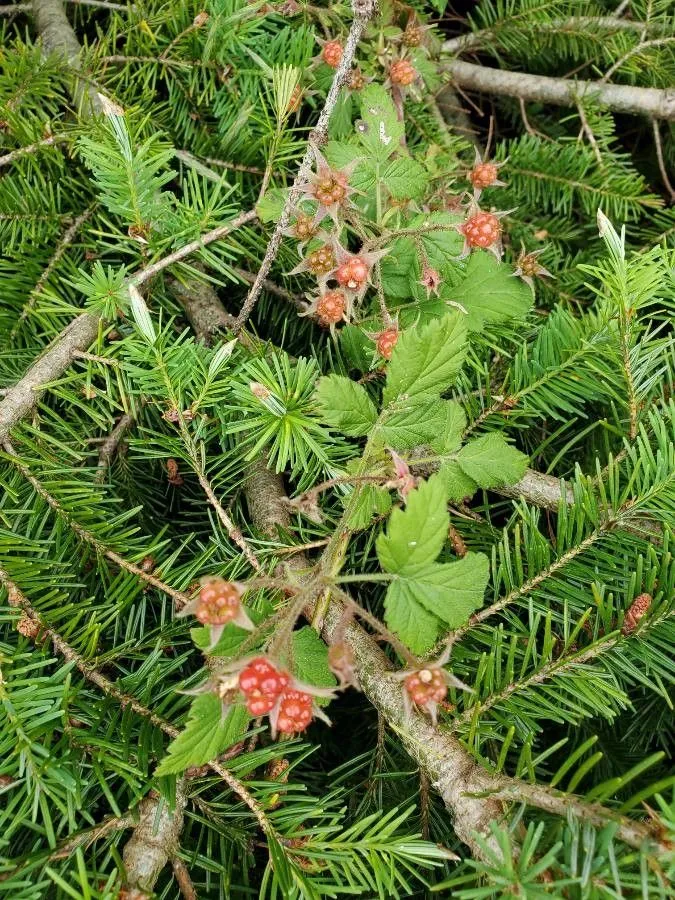
Author: L.
Bibliography: Sp. Pl.: 1197 (1753)
Year: 1753
Status: accepted
Rank: species
Genus: Rubus
Vegetable: False
Observations: China to Vietnam, Sakhalin to Temp. E. Asia, E. & SE. Australia
The Japanese raspberry is an intriguing and versatile species known for its unique characteristics and widespread growth across Asia and parts of Australia. Scientifically identified as Rubus parvifolius, this plant was first methodically cataloged in 1753, exemplifying its enduring presence and relevance in botanical studies.
Belonging to the Rosaceae family, the Japanese raspberry shares a lineage with a wide array of flora best known for their ornamental beauty and economically significant fruit. Its natural habitat spans a considerable geographic range, thriving from China to Vietnam and reaching the temperate regions of East Asia, including Sakhalin. This adaptability indicates the plant’s resilience and versatility in various climatic conditions, contributing to its widespread distribution.
Moreover, the reach of Rubus parvifolius extends to Eastern and Southeastern Australia, showcasing its capability to adapt and endure even outside its primary native regions. This extensive distribution not only highlights the plant’s robust nature but also its potential for cultivation in diverse environmental settings.
Japanese raspberry plants are often recognized for their small yet vibrant fruit, which carries both ecological and potential nutritional value. The berries are typically appreciated by various wildlife, contributing to ecological networks by providing nourishment and assisting in seed dispersion. Furthermore, the aesthetics of Rubus parvifolius—with its delicate foliage and charming berries—make it a valued addition to gardens and natural landscapes.
In conclusion, the Japanese raspberry (Rubus parvifolius) is a noteworthy member of the Rosaceae family with a rich history and a broad distribution from East Asia to Australia. Its adaptability and ecological significance make it an interesting subject of study for botanists and plant enthusiasts alike.
Eng: japanese raspberry, threeleaf blackberry, small-leaf bramble, trailing raspberry
En: Japanese raspberry, Trailing raspberry, Small-leaf bramble, Threeleaf blackberry
Zh: Mao mei, 紅梅消, 茅莓
Ko: 멍석딸기
Zh-tw: 紅梅消
Zh-hant: 茅莓
Taken Jul 19, 2019 by Brett Bissell someguy (cc-by-sa)
Taken Oct 17, 2020 by Ferus00 (cc-by-sa)
Taken Jun 23, 2022 by Brigitte massus (cc-by-sa)
Taken Jun 27, 2020 by Magdalena l (cc-by-sa)
Taken Oct 10, 2022 by Tina H (cc-by-sa)
Taken Oct 17, 2020 by Ferus00 (cc-by-sa)
© copyright of the Board of Trustees of the Royal Botanic Gardens, Kew.
© copyright of the Board of Trustees of the Royal Botanic Gardens, Kew.
© copyright of the Board of Trustees of the Royal Botanic Gardens, Kew.
Taken Feb 20, 2022 by Nikolai Kurzenko (cc-by-sa)
Growth habit: Shrub
Family: Myrtaceae Author: (F.Muell.) K.D.Hill & L.A.S.Johnson Bibliography: Telopea 6: 402 (1995) Year: 1995 Status:…
Family: Rubiaceae Author: Pierre ex A.Froehner Bibliography: Notizbl. Bot. Gart. Berlin-Dahlem 1: 237 (1897) Year:…
Family: Sapindaceae Author: Koidz. Bibliography: J. Coll. Sci. Imp. Univ. Tokyo 32(1): 38 (1911) Year:…
Family: Asteraceae Author: A.Gray Bibliography: Pacif. Railr. Rep.: 107 (1857) Year: 1857 Status: accepted Rank:…
Family: Fabaceae Author: Medik. Bibliography: Vorles. Churpfälz. Phys.-Ökon. Ges. 2: 398 (1787) Year: 1787 Status:…
Family: Aspleniaceae Author: (Cav.) Alston Bibliography: Bull. Misc. Inform. Kew 1932: 309 (1932) Year: 1932…